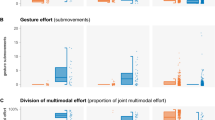Abstract:
Cognitive effort resource planning (CERP) is assumed to be a consequence of technical and personal constraints on performance. The object of this study is the repercussion of CERP for communication of handicapped persons under different environmental situations. The situations differ with respect to the more formal aspects of communicative settings such as the media channels that are used. In experimental situations, the occurrence of CERP can be inferred from observed compensation strategies. These strategies seem to be invariant with respect to channel configurations that characterise specific communicative settings. This suggests that persons adapt in a way that is characteristic of their handicap. The implications of this finding for the design of communicative settings for handicapped persons is discussed.
Similar content being viewed by others
Author information
Authors and Affiliations
Rights and permissions
About this article
Cite this article
de Haan, A., Steenbergen, B., Beumer, J. et al. Communication of Handicapped Persons in a Multimedia Environment. Cognition, Technology & Work 1, 97–106 (1999). https://doi.org/10.1007/s101110050036
Issue Date:
DOI: https://doi.org/10.1007/s101110050036




